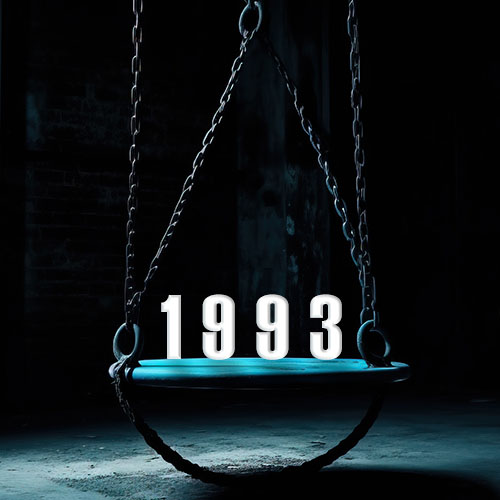Since a secret meeting in 1910 at the island estate of J. P. Morgan, bankers and their hireling politicians have progressively devalued the dollar and our labor to make themselves even richer. A long-term depression will be the result.
The Planned Destruction of the Dollar
Despite my views about the value to society of greater publicity for the affairs of corporations, there was an occasion, near the close of 1910, when I was as secretive-indeed, as furtive — as any conspirator… I do not feel it is any exaggeration to speak of our secret expedition to Jekyll Island as the occasion of the actual conception of what eventually became the Federal Reserve System. — Frank Vanderlip, president of the National City Bank of New York.
One of 1979’s remarkable movies was The In-Laws, a helter-skelter farce starring Peter Falk and Alan Arkin. It was interesting, not only as entertainment but also for what it said about our economy. The In-Laws was the first movie to take the U.S. dollar as its comic premise.
The plot goes something like this: Falk, an apparently demented intelligence agent, draws his would-be in-law, Arkin, through a series of desperate adventures in an effort to save the U.S. economy from hyperinflation. What does it all mean? “Trust the common man,” Arkin shouts, demanding an explanation. Falk responds by describing the Eurodollar market. It seems that less-developed countries (now known as L.D.C.’s) have racked up a debt in the billions, so big that “they’ll never pay it back.” To help repudiate the debt, a Latin dictator (who is a cross between Gen. Omar Torrijos and the fellow who used to peddle velveteen paintings in the parking lots of gas stations) has a plan to destroy the world’s monetary system. He has stolen the engraving plates used to print various currencies, and as soon as he gets the plates for printing the dollar, he plans to run off hundreds of billions. The result, according to Falk, will be an inflation “so big that money is not worth anything. They will be papering walls with it. A six-pack of beer will cost $1,200.”
The funny thing about this movie is that its premise is basically true. Only the details are false. There is a concerted effort to print more and more money, in part to help underdeveloped countries repay their staggering debts with ever more worthless currency. The leaders of this scheme are not the dictators of banana republics but Wall Street bankers and officials in the Carter White House. They are the inflationists who are working to destroy the dollar. They don’t have to steal the plates from the Bureau of Printing and Engraving to do so. They already have them. They use them day in and day out to print more and more money, money that never existed before, money that is nothing but paper with ink on it, money that buys less every day because there is more of it every day.
With the inflationists running the printing presses, you will be lucky if you don’t end up paying $1,200 for a six-pack.
To protect yourself, you need to know more than you can find out at the movies. By the time the evils of paper money have become prominent enough to be impressed upon scriptwriters, directors, and producers in a money-grubbing community like Hollywood, you can be sure that the problem is far advanced.
Inflation has become so pronounced that even persons of the simplest understanding know that money doesn’t buy what it used to. What few understand is why this is so and how the whole process came about. What follows is an account telling who bankrupted America and why.
It is no coincidence that your dollar is worth less today than it was 5, 10, or 20 years ago. Powerful persons want it that way. America has been a wealthy country, and its people have been productive. Only a concerted effort over generations could have emptied your money of value to the point where it is now worth only one-eighth as much as a Confederate dollar, a currency backed by a government that has been defunct for 115 years. Seen another way, it now takes ten times as many paper dollars to buy an ounce of gold as it did ten years ago.
For most of American history, our Treasury Department bought and sold gold at $20 per ounce. Anyone with a paper dollar, from the neighborhood grocer to a foreign government, could turn up in the Treasury with $20 and obtain an ounce of gold. Under those circumstances the dollar quite literally was “as good as gold.” It had to be. The people kept it that way. Not that the politicians and bankers did not try to reduce the value of money; they did. Yet in spite of all the wars and innumerable inflationary banking “bubbles” of the nineteenth century, the dollar in 1913 was worth as much as it had been in 1813. The dollar remained a sound money because the government could not create additional dollars beyond what the people really wanted. As long as the people retained an easy way of bringing inflation to a halt, it was impossible for inflation to get out of hand. People merely had to go to the Treasury and redeem their paper for gold.
The politicians and bankers, of course, did not want to be controlled by the people. In 1913 the Federal Reserve Act was passed, largely as a way of facilitating inflation. The new system reduced popular control over the money supply. It made printing money easier by making it more difficult for consumers to withdraw assets from inflationary banks. With the people less able to reduce the money supply, bankers were able to increase their profits by expanding the money supply.
To see how that works, take a closer look at the banks themselves. For many people banks are merely institutions that will lend money when you don’t need it. But they are more than that. They control money in America. They not only manage your checking account but also help define what money is. They can create money, reducing the value of each dollar you own by lending new dollars to other people. In the process the banks redistribute wealth, enriching some, impoverishing many, and plunging the nation deeper and deeper into debt. Next to politicians, you can thank the banks for mortgaging your future.
“Only a concerted effort could have emptied your money of value to the point where a U.S. dollar is worth only one-eighth as much as a Confederate one-backed by a defunct government.”
Can banks really be that important? Thomas Jefferson thought so. He wrote that a central bank monopoly, such as the Federal Reserve, is an “institution… of the most deadly hostility existing against the principles and form of our Constitution… I am an enemy to all banks, discounting bills or notes for anything but coin.” In other words, if Jefferson were alive today, he would oppose almost every banking institution that exists in America. This opposition to paper money, created through the banking system, was not peculiar to Jefferson. Both Andrew Jackson and Martin Van Buren were elected president largely on the basis of their opposition to paper money. Daniel Webster wrote: “Of all the contrivances for cheating the laboring classes of mankind, none has been more effective than that which deludes them with paper money.” As late as 1857, the Oregon Constitutional Convention decided, after a fierce debate, to ban banks from the state altogether as a means of limiting credit manipulation and prohibiting paper money. Article XI, section 1, reads as follows: “Prohibition of State Banks. The Legislative Assembly shall not have the power to establish or incorporate any bank or banking company, or monied institution whatever, nor shall any bank, company, or institution exist in the state with the privilege of making, issuing, or putting into circulation any bill, check, certificate, promissory note, or other paper of any bank, company, or person to circulate as money.”
This extraordinary constitutional provision reflects early American interest in banking laws. It also shows the feeling on the part of the entrepreneurs of an earlier age, the farmers, merchants, and prospectors, that the evolution of a credit economy was hurtful to their interests. However naive the Oregon frontiersmen may have been in hoping that they could eliminate banking institutions altogether, they at least recognized that the operation of banks was of major importance to their lives. The banks were a passionate issue because everyone rightly recognized that they mattered.
They matter today. In fact, they matter more than ever before. A concerted effort by inflationists over a period of generations has succeeded in almost completely eliminating your control over your own money. Today your income, savings, life insurance, real estate, stocks, and other assets are denominated in terms of dollars with no certain value. No one who knows what the dollar is worth today can guess what it will be worth a year from tomorrow. It is of little good to people that they have worked hard to earn more money if the more that they earn buys less than a smaller sum did years ago. But whether the money is worth much or little, it is all but impossible for the citizens themselves to control its value. That is a task completely monopolized by politicians and bankers.
A crucial step toward this political control of money was the passage of the Federal Reserve Act on December 23, 1913. The provisions of this act were determined by that day’s most eminent inflationists, including Sen. Nelson Aldrich, grandfather of David Rockefeller; Jacob Schiff of Kuhn, Loeb, and Company; and Piatt Andrew, assistant secretary of the treasury. This group gathered at the estate of J. P. Morgan at Jekyll Island, Ga., to draft the charter that would change the nature of America’s money. Also present were Henry P. Davison, senior partner of J.P. Morgan and Company; Frank Vanderlip, president of the National City Bank of New York; Paul Warburg of Kuhn, Loeb, and Company; and Charles D. Norton, president of First National Bank of New York. This group, nicknamed the “Money Trust” by its opponents, conceived the plan for the Federal Reserve system and enacted it into law.
The Federal Reserve System, which began as 12 regional banks, inaugurated a new kind of currency in America — the Federal Reserve note. Unlike other American money at the time, it was not redeemable in silver or gold. In fact, it was not even “lawful money.” A Federal Reserve note was merely an IOU issued by the banks as an instrument of debt. Provisions of the original Federal Reserve Act (12 U.S.C. 411) read as follows: “Federal Reserve notes to be issued at the discretion of the Board of Governors of the Federal Reserve System… They shall be redeemable in lawful money on demand.”
Freed from the requirement of redeeming all paper money directly with the public for gold or silver, the banks were able to inflate with less restraint. Instead of backing the dollar solely with gold, they backed their Federal Reserve notes with debt. The politicians loved this, because in practice most of the money printed by the banking system went to finance budget deficits.
Here’s how it works. When the politicians want more money, they dispatch a request to the Federal Reserve for whatever sum they desire. The Bureau of Printing and Engraving then prints up bonds indenturing taxpayers to redeem their debts. The bonds are then “sold” to the Federal Reserve. But note this unusual twist — the bonds are paid for with a check backed by nothing. It is just as if you were to look into your account and see a balance of $412 and then, hearing that government bonds were for sale, write out a draft for $1 billion. Of course, if you did that, you would go to jail. The bankers do not. In effect, they print the money that enables their check to clear.
Originally, there were limits to how much money the banks could print in this fashion. The Federal Reserve System as a whole was obliged to maintain a 40 percent gold backing for its notes. This placed a limit on inflation, which the banks bumped into in 1929. But by 1913 standards a gold backing of only 40 percent was a great inflationist victory. It gave the banks far greater license to cheapen money than they had ever achieved before.
Not only did the Federal Reserve Act introduce a new type of currency, the Federal Reserve note; it also reduced the reserve requirements in the banking system. Prior to the passage of the Federal Reserve Act, most banks had to retain a reserve of 25 percent of total deposits in cash in the bank’s own vaults. The Federal Reserve Act reduced the reserve requirements to as little as 12 percent for checking accounts and 5 percent on savings deposits.
These changes made the banking system more inflationary. From 1913 on it was much easier for bankers to create credit. That’s another way of saying that they could lend out other people’s money more often. With a reserve requirement of 25 percent, a bank with $1 million in deposits could lend out $750,000. If that lent money were then redeposited in the banking system, $562,500 could then be lent out again. Assuming that the proceeds of the loan were redeposited, a third loan could be lent out for $421,880. This process could continue, with the same money being lent out over and over until the original $1 million was 25 percent of total loans. At that stage every cent of liquidity beyond the reserve requirements was tied up in loans.
Reduce the reserve requirements, and you immediately increase the profits of the banks. They can collect more income by lending other people’s money more often. With a 10 percent reserve requirement, a bank with $1 million in deposits could lend out $900,000. If that money were then redeposited, as lent money almost always is, $810,000 could be lent out again. That could be followed by a further loan of $729,000 and so on, until the original $1 million was only ten percent of total loans.
“For most of American history the Treasury bought and sold gold at $20 per ounce. The dollar quite literally had to be “good as gold.” In 1913 the dollar was worth as much as it had been in 1813.”
By this simple example it is clear why the banks have a strong interest (in more senses than one) in reducing the reserve requirements. The income from lending $10 million is much greater than that from lending $4 million (what they could lend with the same $1 million and a reserve requirement of 25 percent). Obviously, the bankers cheered when the Federal Reserve Act reduced reserve requirements.
Unhappily for the country, the banks lost no time in putting their new Federal Reserve System to full advantage. Immediately after the act was passed, they embarked upon a great inflationary credit binge, which was further aided by the requirement to finance the vast debt arising out of World War I. Making full use of their power to print paper money, with reserves for savings deposits reduced to only three percent, the banks greatly expanded their liabilities while actually reducing the cash in their tills.
By June 30, 1930, the total savings and checking accounts in Federal Reserve Banks had risen to $32 billion, more than double the amount prior to U.S. entry into World War I. But the holdings of cash in bank vaults had actually declined from about $800 million to only $500 million.
This contributed importantly to creating the Great Depression. The bank’s policies of excessive inflation during the 1920s stimulated an artificial, unsustainable boom. It was not a new process but a phenomenon as old as paper money itself. Thomas Paine, American revolutionary and author of Common Sense, put it this way: “One of the evils of paper money is that it turns the whole country into stock jobbers. The precariousness of its value and the uncertainty of its fate continually operate, day and night, to produce this destructive effect.” This certainly was true during the twenties.
Speculation, stimulated by cheap money, led to dramatic overinvestment by business. Everyone and his brother took wild flings in the stock market in the hope that the inflated values would make them rich overnight. Like the credit speculation in real estate today, the average speculator was operating on only a 10 percent margin — borrowing nine dollars of every ten dollars to finance his investment. Eventually, the credit binge had to stop. When it did, many banks went under. Under the operation of the Federal Reserve Act their cash on hand had dwindled to only 1.5 percent of their deposit liabilities. Obviously, many people came up empty when they went to the bank to draw out their money.
The story of the Great Depression is too well known to repeat here. Everyone has heard the tales of poverty and distress that grew out of this great monetary manipulation. Some sold pencils or apples on the corner. Others stood in long lines at soup kitchens. To the inflationists this was all evidence that the monetary system required more “flexibility.” They sought to create a situation in which the banks could inflate indefinitely without the possibility of finding themselves overextended, as they had in 1929. To that end, a legal tender law was enacted in 1933, making Federal Reserve notes legal money. At the same time citizens were deprived of the right to come to the Treasury with currency and convert it into gold. As of 1933, only foreign governments could convert to dollars.
These “reforms” were further steps toward a purely political money. Silver Certificates and silver coins did remain in circulation, but they made up an ever less significant portion of the money supply. Since the gold standard was repudiated, the bankers and politicians were given a free rein to profit from inflation. They have since printed hundreds of billions in paper money backed by nothing but their own doubtful integrity. It is little wonder, then, that the late congressman Louis Thomas McFadden, himself a banker and one-time chairman of the House Committee on Banking and Currency, said in an unguarded moment “The sack of these United States by the Fed is the greatest crimes in History.”
There were only trivial changes in America’s domestic monetary structure from the thirties to the sixties. However, our story would not be complete without consideration of some of the important international developments dating from the end of the Second World War. It was then that representatives of the Western countries met at the Mount Washington Hotel in Bretton Woods, N. H., to establish a new international monetary structure. The new system enshrined the U.S. dollar as an international reserve currency for use in settlement of debts and the conduct of international trade. The other currencies within the system, the British pound, the French franc, etc., were all pegged at fixed exchange rates against the dollar. The dollar, in turn, was guaranteed by the U.S. government to be worth one thirty-fifth of an ounce of gold. Foreign central banks had the right to trade in their dollars in exchange for gold at any time.
When this arrangement was struck in 1944, the world was engaged in a devastating war. All the economically advanced countries were combatants. Of these, only the United States and under-populated Canada emerged relatively unscathed. In these unhappy circumstances the American economy was far and away the strongest in the world. American diplomats and banking officials, representing much the same configuration of interests denounced earlier as the “(Paper) Money Trust,” played on this advantage successfully.
Instead of building for a solid prosperity with other countries, they used the newfound status of the dollar as an international reserve currency to cover the printing of money. This was facilitated by artificially undervaluing the dollar in the fixed exchange rates by pegging these rates at prewar levels. Naturally, since the dollar was a bargain on those terms, foreigners were anxious to obtain and hold it. With billions of dollars being squirreled away in foreign countries, the inevitable consequence was a much-heralded “dollar shortage.”
As long as the dollar remained artificially low in price relative to other currencies, American politicians and banking interests were utterly free to print as much money as they pleased. Indeed, they had the support and encouragement of some foreign governments that needed additional dollars to provide reserves for their own currencies and to conduct international trade.
In retrospect, the political decision to undervalue the dollar artificially in a system of fixed exchange rates was a remarkably stupid move on the part of other countries. Had the dollar’s value relative to foreign currencies been set at the going rate, there never would have been a “dollar shortage.” Foreign banks and governments would thus have been sensitive to the inflation in the United States. We would not have been able to finance the purchase of raw materials and foreign goods through the printing press. Other people would not have let us. Instead of hoarding dollars, they would have moved more quickly to turn them in to the various banks around the world, which would have redeemed them for gold. As it was, persons at home and abroad were snookered into holding dollars that could be printed at will by the American inflationists.
That is exactly what happened. The printing presses rolled, churning out billions and more billions. By the time Europeans, the Japanese, and others caught on, they had so many dollars stashed away that it was difficult for them to take decisive action. To force a devaluation of the dollar by converting it into gold would necessarily have meant devaluing their own reserves.
Nonetheless, by the sixties it was obvious that the total dollar liabilities far exceeded the U.S. government’s supply of gold. That had stood at $25 billion (at $35 per ounce) at the end of World War II but had declined steadily since 1949. Anyone who could count should have seen that devaluation of the dollar in terms of gold was inevitable. President de Gaulle of France realized this, cashing in billions of dollars. Other countries were not so quick to act — partly because American politicians made every effort to disguise the truth. Indeed, the first overseas television broadcast showed President John Kennedy proclaiming that the United States would maintain the value of gold at $35 an ounce forever.
It did not happen that way. As more billions were printed to finance the Vietnam War and as gold supplies dwindled, Congress acted in 1965 to abolish gold reserve requirements for Federal Reserve deposit liabilities. This meant that the printing presses could run even faster. In that same year the Treasury replaced real silver in the coins with slugs. The dollar had been so inflated that the silver content of dimes and quarters exceeded their face value. As a result, hundreds of millions of coins disappeared from circulation in early 1965 as citizens saved them as a hedge against inflation or melted them down at a profit. These developments were all symptoms of the remorseless expansion of the U.S. money supply. By 1965 the dollar had lost more than half of its 1945 value. (Today a real dime from 1965 is worth more than a paper dollar.)
Lyndon Johnson kept the printing presses going around the clock, while doing his best to browbeat our allies into stockpiling new hoards of dollars rather than converting them into gold. This worked but only temporarily, while many of the foreign governments could be intimidated, foreign citizens could not. Increasingly, they turned their dollars into gold on London’s private market. As selling of dollars intensified, the price of gold rose above $35 per ounce. By 1968 the U.S. government no longer had enough gold to sell in private markets to fix the price at $35 per ounce. As gold soared, Johnson promised that the United States would maintain the official parity at $35 per ounce only for dealing with other governments. From that point on it was only a matter of time until the system collapsed. The United States continued to deliver gold, but no other government was stupid enough to trade an ounce of gold for $35.
As the 1970s began, the U.S. government continued to print money. Foreigners became increasingly alarmed. In a last-ditch effort to save the dollar and thus prop up the value of their reserves, the Japanese and European central banks decided to mop up excess dollar supplies by using them to buy U.S. government bonds. In 1970 alone almost $20 billion was spent that way. It did no good. By 1971 U.S. budget deficits had orphaned more than $83 billion U.S. dollars in Europe (Eurodollars) while U.S. gold supplies had dwindled to only $9 billion ($35 per ounce).
Finally, on August 15, 1971, Richard Nixon officially repudiated the promise of the U.S. government to back the dollar with gold. Our politicians had defrauded our allies, just as they had plundered the people at home. Nixon’s announcement was a tacit admission that the U.S. government was bankrupt. American money would henceforth be backed by nothing. No one, not citizens, not businesses, not even foreign governments, would be able to call the U.S. inflationists to account. From 1971 on the U.S. dollar has not been backed by gold at any price. There has been no outside force limiting the printing of dollars.
It is hardly surprising, therefore, that since 1971, inflation has been worse than ever. Politicians and bankers, freed of practically every restraint on the creation of money, have turned out so many new dollars that the financial condition of the American people has become almost as desperate as that of our already bankrupt government. Real purchasing power for seven out of ten persons has actually declined to less than it was 13 years ago — before the gold convertibility was repudiated. Most people have found it impossible to earn as many additional inflated dollars as they would need to maintain their standard of living. For one thing, the “progressive” tax system means that your taxes go up 16 percent every time your income increases by ten percent. But that’s only part of the problem. Long-time inflation destroys an economy. Someone must earn every bit of income that anyone receives. Inflation makes that more and more difficult.
While American politicians have been printing money, people in other countries have been learning to be more productive. With each year that passes, the products in Europe, in Japan, and even in areas such as Korea and Taiwan have improved in quality and price, thus driving American goods out of world markets. Who in Tokyo would want to buy an American television? Or an American camera? American automobiles are curiosities in Europe. Outside of large computer technology, which is heavily subsidized by the Pentagon, there is only one field in which America shows a wholesome export account: agriculture.
We are gradually becoming an oversized banana republic, exporting food-stuffs for cash.
Many of our basic industries are without sufficient investment funds to modernize. The tax laws, written to subsidize the banks, encourage borrowing but not investment. This increases the inflationary spiral, making business appear to be profitable when it is not. Inventories are overvalued because of inflation, and depreciation allowances are insufficient to actually replace plants and equipment.
It’s like what happened in Germany in the 1920s. A grocer may have bought a loaf of bread for 10,000 marks and sold it for 50,000. Did he make a profit of 40,000 marks? No. He made a loss, because to buy another loaf of bread and stay in business he had to spend 100,000 marks. Major American industries are suffering because of just this problem. They are paying taxes on “profits” that are actually losses. Business Week recently examined the real position of just one American corporation — U. S. Steel. It found that the real cumulative cash flow for that company was $3.498 billion in the red over the last five years. Productivity is declining. Our steel industry’s capacity is actually less than it was years ago. American companies would have to double their annual investment — which they do not have the money to do — “merely to maintain existing facilities…” Our steel industry is so poor that its facilities are 20 years behind those of Mexico.
A survey of all the ways in which the American economy is being bankrupted by inflation is beyond our limits. Suffice it to say that the process is well under way. Productivity in two-thirds of our major industries is declining. We are no longer producing what we wish to consume.
Instead of being stimulated by the further issue of paper money, our economy is in the phase of stagnation that precedes collapse. Figures compiled by Hamilton Boulton, founder of the Bank Credit Analyst, documented the diminishing effect of credit inflation in “stimulating the economy.” From 1949 to 1953, each 17 percent increase in bank credit produced an additional dollar rise in Gross National Product. (The GNP is the total value of all goods and services produced in the United States.)
From 1960 through 1965 it took 46 cents in additional bank credit to produce another dollar increase in the GNP. As inflation worsened from 1966 to 1968, it took $1.03 to yield one dollar in the GNP. From 1975 to 1978 it took $1.38 in credit expansion to stimulate another dollar increase in the GNP.
And from March 1978 through March 1979, it took $1.88 to increase the GNP by another dollar. In other words, it now takes more than ten times as much inflationary credit expansion to stimulate the economy as it did 30 years ago. As investment economist Richard Russell comments, “This ominous trend is highly inflationary, an indication of an economy that’s bogging down and becoming increasingly fat and inefficient…”
As the American economy has suffered from inflation, consumers have gone ever more heavily into debt, both as a tactic to profit from continued depreciation of the dollar, and simply to maintain their standard of living in the face of declining purchasing power. The average household now spends almost 25 percent of every dollar to service overdue bills. This means that consumers are in the most illiquid condition they have been in since the last depression in the thirties.
In many households both husband and wife now work. Some observers attribute this to Women’s Lib without bothering to consider what else the trend might mean. A survey by the Roper organization suggests a more disturbing explanation of why so many women are entering the labor force. Far and away the greatest reason provided by the women themselves for getting jobs was to make ends meet. Inflation has taken such a toll that they can no longer support their families on a single income. Under these conditions it is no exaggeration to speak of bankruptcy. In 1913, when the Federal Reserve was created, long-term debt in America amounted to only 19.7 percent of total estimated national wealth. Today America is mortgaged to the hilt. The present value of government spending liabilities in the Social Security program alone exceeds the whole wealth of the nation. This says nothing of explicit government debt that people are also squeezed to pay through taxes. This debt now amounts to more than a trillion dollars. But most important for our story is the fantastic consumer installment and mortgage debt. This debt has been rising twice as fast as personal income since the early 1950s. As the inflationary squeeze has intensified since 1975, consumers had to lengthen the terms of their debts, mortgaging themselves far into the future. It is this staggering debt burden, with new borrowings exceeding repayments, which has maintained consumer spending.
But new borrowing cannot indefinitely multiply beyond income. When debt too far exceeds wealth, there must be a collapse to bring the two back in line.
Pinpointing just when such a collapse will occur is like trying to say exactly how long an aged man will live. Even if he is now 89 years old, with a weak heart, there is no telling how long he might hang on. With good luck, he could live to be 100. But no one should be surprised if he were to collapse tomorrow.
That is the condition of the economy today. It is bankrupt. Busted. Any further reduction in consumer spending power could touch off a chain reaction of business closings, leading to unemployment, further reductions in purchasing power, further business closings, and still more unemployment. Under such conditions businesses would default on their loans. Delinquencies on consumer installment and mortgage debt would rise. And this could put the already overextended banking system in jeopardy.
Loan losses must be charged against a bank’s capital account. But there is scarcely a bank in the country with enough capital to support massive bad-debt write-offs. Mortgage debt and consumer borrowing on bank cards, such as Visa and Master Charge, now exceed the capital of the average commercial bank by almost three times.
The politicians and bankers may have unwittingly set in motion the forces that will destroy their inflationary empire by sponsoring the so-called energy crises. As explained in the July 1979 issue of Penthouse, the energy crisis is not an energy crisis at all but part of the monetary crisis, whose origins we have analyzed here. When Nixon turned the dollar into unadulterated funny-money on August 15, 1971, he not only delivered the final blow to the world monetary structure but also removed the last barrier to a new kind of inflationary banking.
With all structural limits on inflation ended, large American banks have increasingly centered their activities broad — in the Eurodollar market. Because there are no reserve requirements or other regulations limiting the creation of credit with American dollars orphaned abroad, the big banks saw the opportunity to make high profits. Instead of being limited so that each dollar deposit had a credit leverage of from six to ten dollars, as it does in the domestic banking system, the banks could establish their own limits in the Eurodollar market. James Hugon, economist for the comptroller of the currency, has estimated that the reserves backing up the Eurodollar market may be as small as 2 percent of total liabilities. That means that the banks could have created as much as 50 times more credit than they actually have dollars.
No one really knows, however, because it is so difficult to obtain reliable figures on the size of the Eurodollar market. Estimates vary from as low as $200 billion to as high as $1 trillion. Reserves are flowing from one bank to the next and country to country so rapidly that it is hard to tell just what is happening. The debt of one bank may be a credit in another. A bond, note, or other instrument of indebtedness may become collateral for obtaining still more debt from another bank or lender. Thus the liabilities multiply from bank to bank and country to country.
The fluctuating value of all currencies, as countries inflate at different rates, causes billions to cross borders every night. This gives banks the opportunity to profit from the day-to-day fluctuation in exchange rates as well as to earn billions in longer-term speculations. These take the form of loans that have maturities of five years or more and are typically financed out of short-term deposits. In fact, almost 25 percent of all Eurodollar deposits have maturities of less than eight days.
This kind of high-risk banking varies from a crap shoot primarily in that the sums involved run into the hundreds of billions rather than pocket change. While things go well, of course, the banks can profit handsomely. Analyst Mark Hulbert’s comments: “The top 12 U.S. banks in 1975 had loaned only 32 percent of their assets abroad; yet foreign loans accounted for 63 percent of their earnings. The top two banks, Bank of America and First National City Bank, in fact took losses on their domestic operations in 1975, receiving their entire profits from foreign operations. David Rockefeller’s Chase Manhattan Bank received 78 percent of its earnings from international lending.”
Much of the profit that the big banks earned a few years ago came from the loans of tens of billions at high interest rates to help countries with primitive economies finance their balance-of-payments deficits. These deficits were dramatically aggravated by the increase in world oil prices beginning in 1973. Every time the oil price goes up, that places these debtor countries in worse condition. U.S. banks and the foreign branches of U.S. banks are now owed $53. 1 billion by these less-developed countries. These debtors have not even finished repaying the loans they incurred after the major oil price increase of 1973. Now, according to Ernest Stern, vice-president of the World Bank, they must borrow $50 billion more to pay for the 1979 oil price increase.
Already some of these debts have had to be “rescheduled” — a polite way of saying the debtors are in default. For example, in 1978, interest and amortization on a quarter of a billion dollars owed by Peru was rolled over by a consortium of banks led by Manufacturers Hanover Trust. At the same time, 24 of these less-developed countries joined together in a new group named, imaginatively, The Group of Twenty-Four to demand re scheduling of loan payments and press for more inflation in the industrialized world. The group, chaired by A.G.N. Kazi, governor of the State Bank of Pakistan, not only demanded more paper money but also supported steps to make all currencies worth less. In fact, it specifically urged that the International Monetary Fund apply pressure to low-inflation countries like Japan and West Germany to force them to inflate their currencies as fast as the United States is doing. In other words, their agenda was little different from that of the mad dictator of The In-Laws, who plotted to escape his debts by inflating Western currencies.
That’s not the attitude of solvent, credit-worthy borrowers. With the debtor countries begging for more money and unlikely to earn it on their own, the banks that have lent these billions are in serious trouble. Without a dramatic change in the flow of funds worldwide, they could collapse.
Thus, the “energy crisis.” Its basis is not oil, but money. By reducing American purchases of foreign oil, the bankers and politicians hope to generate a sufficient shift in cash flows to bail out the debtor countries and thus the banks. To do this, they are promoting policies, such as those embodied in Jimmy Carter’s “energy program,” that will further lower the already declining living standard of the American people.
Carter has imposed a quota on oil imports, limiting the amount of cheap foreign oil that Americans can enjoy, while proposing to spend $100 billion to produce more expensive synthetic alternatives. The tax aspects of Carter’s plan will discourage domestic production of ordinary petroleum while offering loan guarantees for synthetic development — thus providing the big banks with guaranteed profits for further credit creation. The banks will lend billions to finance production of oil from shale rock at $50 per barrel so that you and other consumers can avoid paying one-half or one-third that amount for ordinary petroleum.
This latest inflationist scheme may be too clever by one-half. The gasoline shortage of 1979 engineered by the Carter administration to pave the way for its “energy program” came close to precipitating a collapse of the debt structure. Seeing how mismanaged and vulnerable the economy is and realizing that an ever higher portion of purchasing power would be needed just to buy necessities, consumers curtailed their spending. Sales of expensive items were especially hard hit. As inventories piled up in furniture and appliance stores, retailers were placed in a cash squeeze. The result: dramatic sales and price reductions to lure in additional cash needed to finance operations. Many small businesses went under. Even in the Washington area, with its hordes of overpaid politicians and bureaucrats, small-business bankruptcies reached record levels in mid-summer 1979. Throughout the country car dealerships failed, and the impending bankruptcy of Chrysler, America’s tenth-largest corporation, became frontpage news. Soon even dealers of gas-efficient foreign cars, such as Toyota, were offering price reductions and rebates. In the Northeast gasoline prices actually fell in New York City. And for the first time ever, the McDonald’s Corporation announced a reduction in the price of its hamburgers. These steps all reflected the erosion of consumer spending.
It is still too early to tell how far this chain reaction must go. At least 25 million families face substantial reductions in purchasing power. This means trouble for many in such vulnerable industries as construction; automobile, appliance, and furniture assembly; men’s clothing; and discount retailing. Millions in these and other businesses face unemployment. Furthermore, almost 20 million families with two income earners face the prospect that an economic slowdown will cost working wives their jobs. This sudden reversal of fortune among people who have been spending and borrowing to the hilt could lead to installment and mortgage delinquencies. And the upshot of it all, predicts economist T. J. Holt, will be tar worse than any observers realize: “Large-scale defaults on consumer loans will cause banks to contract commercial lending. That’s a classic ingredient of a depression.”
Even America’s strong agricultural economy is being increasingly jeopardized by the bankruptcy of other sectors upon which farmers depend for survival. For example, the railroads that haul cash crops to market have become so dilapidated that they threaten to collapse. taking hundreds of landlocked farming communities with them. Says Tom Phillips, a spokesman for the Chicago-based Milwaukee Road, “There’s no question that some shippers are going to be driven to the wall and may find themselves in a hell of an economic squeeze.” The Milwaukee Road is losing $500,000 per day. Much of the railroad’s track is in such poor repair that federal court orders prohibit locomotives from proceeding faster than ten miles per hour on more than 650 miles of the main-line track. As farmers gathered in Denton, Mont., in the fall of 1979 to load their grain, they watched as the track below the train slowly gave way. It leaned farther and farther over and finally flopped on its side — a collapse that was symbolic of what is happening to the economy in this country.
Whether the proprietors of the printing press will be able to slap enough green ink on paper to put a failing economy back on its feet is the question of our time. Many experts feel that there is no way that the economy can ever collapse into bankruptcy and depression so long as the Fed is standing by, committed to print any amount of money that might be needed to keep the banks solvent. We are told not to sorry. But this calm counsel may not be correct. One person who thinks it’s not is William McChesney Martin, who was chairman of the Federal Reserve Board under five presidents — Truman, Eisenhower, Kennedy, Johnson, and Nixon. Martin not only believes that a depression is possible; he believes it is likely. He has said, “The U.S. central bank alone can’t protect the American economy from an economic collapse. I believe there’s a good chance that we’ll have another depression within the next three to five years.”
By bankrupting the middle class. the politicians may have touched off a chain reaction of bankruptcies that will eventually destroy their robber’s world of paper money. Once again, the painful lesson will be relearned. The printing presses cannot provide prosperity. The creation of debt through a monopolistic banking system cannot replace the need for people to work, produce, and save in order to build a continuing prosperity. What Thomas Jefferson spelled out long ago remains true today: “We are now taught to believe that… tricks upon paper can produce as solid wealth as hard labor in the earth. It is vain for common sense to urge that nothing can produce but nothing; that it is an idle dream to believe in a philosopher’s stone which is to turn everything into gold and redeem man from the original sentence of his Maker, ‘In the sweat of his brow shall he eat his bread.’”
























